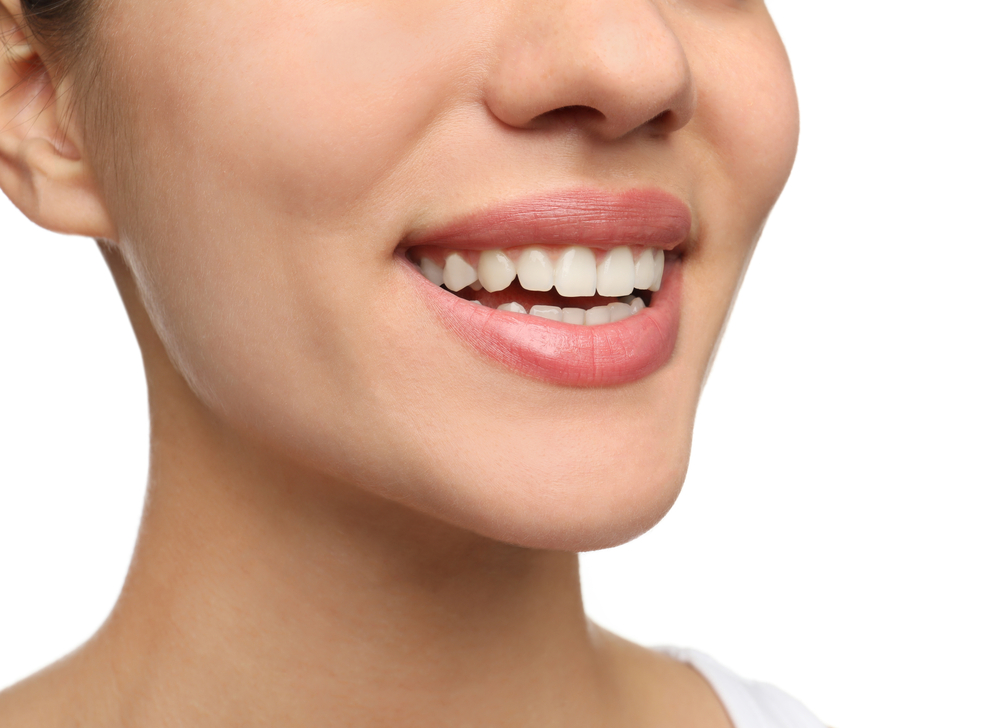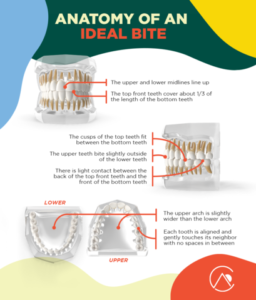You probably have a good idea of what a perfect smile looks like. But you might be less familiar with what an ideal bite looks like. In fact, patients are sometimes surprised to learn they even have a bite problem at all. To help give you some clarity, I’ll be covering everything you need to know about your bite.
What Does “Bite” Mean in Orthodontics?
Your bite, or dental occlusion, refers to the relationship between the teeth in the upper jaw and the teeth in the lower jaw and how they fit together.
With a normal, or ideal, bite, the top and bottom teeth meet in a comfortable way that distributes bite forces properly and promotes harmony in the entire chewing system (i.e., teeth, gums, jaws, chewing muscles, jaw joint, etc.).
What Does an Ideal Bite Look Like?
While visiting an orthodontist is the only way to determine whether or not your bite is aligned, you can get a general idea by looking in the mirror.
If you bring your upper and lower teeth together, when viewed from the front:
- The edges of the top teeth should be parallel to the bottom lip, following its curve
- The top front teeth should cover about ⅓ of the length of the lower front teeth
- The upper midline (the line between the top front teeth) should be in the center of the upper lip. The upper and lower midlines should also line up.
When viewed from the side:
- All of the upper teeth should bite slightly outside of the lower teeth
- The cusps, or points, of the top teeth should fit between two bottom teeth
- The back of the top front teeth should have light contact with the front of the bottom teeth
If you were to open wide and look at your entire upper and lower arch:
- The teeth in each arch should follow an even curve
- Each tooth should gently touch its neighbor without overlapping or having spaces in between
- The upper arch should be a tiny bit wider than the lower arch
Why is Having a Healthy Bite Important?
When you have crooked teeth or a discrepancy in jaw size that interferes with the bite, it can cause a number of complications.
Having a healthy bite, on the other hand:
- Makes teeth easier to clean, reducing your risk of tooth decay and gum disease
- Distributes chewing forces correctly, helping you avoid breakage and uneven enamel wear
- Allows you to bite into foods and chew properly
- Makes teeth less susceptible to injury (protruding teeth are in harm’s way)
- Encourages facial symmetry and improves your appearance
- Prevents undue stress on the temporomandibular joint (TMJ) and chewing muscles, alleviating TMJ pain, facial pain and headaches
- May help with teeth grinding and clenching (bruxism)
- Can promote a healthy airway and proper breathing
- Lets you speak clearly
- Keeps the jawbone healthy and strong
What is Malocclusion?
Now that you know what an ideal bite looks like, let’s talk about the opposite: malocclusion. Malocclusion translates literally to “bad bite.” When you have malocclusion, whether due to the teeth, the jaw or both, the upper and lower arches don’t come together properly.
While there are classes and divisions of malocclusion, for the purpose of this blog post, I’ll just give you the basics. The most common types of malocclusion include:
- Crowding – Crowding is when the jaw is too small to accommodate all of the teeth. As the teeth try to squeeze in, they often overlap, twist or get blocked out of line. This makes keeping up with proper oral hygiene difficult. It can also cause uneven wear on the teeth.
- Spacing – Spacing is when there are gaps between two or more teeth. Gaps tend to trap food debris and plaque, compromise gum health and can cause bone loss.
- Excessive Overbite (Deep Bite) – As you saw with an ideal bite, a little bit of an overbite is a good thing. However, when the top front teeth cover too much of the bottom teeth, you’re said to have an excessive overbite, or deep bite. In extreme cases, the bottom teeth can bite into the roof of the mouth causing trauma and wear to both the teeth and gums.
- Underbite – When a patient has an underbite, their lower jaw and teeth are positioned in front of the upper jaw and teeth. The lower jaw can trap the upper jaw, preventing upper jaw growth. Since it’s usually a skeletal issue, early intervention can be the key to addressing an underbite without having to resort to corrective jaw surgery.
- Overjet – People often use overjet and overbite interchangeably but they’re actually two different conditions. Overjet is a measure of horizontal distance between the top and bottom front teeth, while overbite measures the vertical distance. When a patient has overjet teeth, the front teeth protrude, or stick out, too far in front of the bottom teeth.
- Crossbite – A crossbite is when one or more bottom teeth sit in front of the top teeth. If the teeth in the back of the mouth are involved, it’s called a posterior crossbite, or back crossbite. When the teeth towards the front of the mouth are in crossbite, it’s called an anterior crossbite, or front crossbite. Similar to an underbite, the lower jaw can sometimes trap the upper jaw and lead to abnormal or asymmetric jaw growth.
- Open Bite – If you have an open bite, your top front teeth don’t overlap your bottom teeth at all. You may even have a visible opening between the upper and lower teeth when the back teeth are touching. This makes it hard to bite and chew.
How are Bite Problems Diagnosed?
As board-certified orthodontists, Dr. Cronin and I have extensive training in diagnosing even subtle bite issues. To do this, we take diagnostic records, such as x-rays and photographs, and perform an exam.
Some of the things we look for include:
- How your upper jaw and lower jaw are balanced to one another and your skull
- How your teeth are positioned in relation to your lips and facial features
- Whether you have missing or extra teeth
- Whether or not the midlines are centered
- How much of the lower front teeth are visible when the jaws are closed
- The width of the upper arch in comparison with the lower arch
- How the cusps of the back top teeth fit in between the lower teeth
- Whether the top front teeth come into contact with the bottom front teeth
- Whether the teeth in each arch are aligned and touching one another without overlapping or having spaces in between them
- Whether your teeth are too small or perfectly sized
How is a Bad Bite Treated?
If you don’t have an ideal bite, the good news is, it can be fixed! While it will depend on your unique smile and the severity of your case, treatment options could include:
- Phase 1 Orthodontic Treatment – The American Association of Orthodontists recommends kids have their first orthodontist visit no later than age 7. At this age, most kids have their first permanent molars and the back of the bite is established.
The majority of kids won’t need intervention this young, but there are some skeletal problems that respond best to treatment between the ages of 7 and 10, before peak growth is complete, such as an underbite, some posterior crossbites or an emerging, severe overbite.
Early interceptive treatment, or phase 1 treatment, allows Dr. Cronin and I to use an orthodontic appliance, like a rapid palatal expander, to guide jaw growth and make room for the permanent teeth to erupt properly. Then, after a resting period, kids will usually start phase 2 treatment with braces or Invisalign Teen once all of their permanent teeth are in.
This approach can make the second phase of treatment in the teenage years much easier and more affordable. It can also help kids avoid the need for corrective jaw surgery or extractions later in life.
- Braces – Braces are effective for treating a range of bite problems in patients of all ages. The system of brackets and wires exerts steady, gentle pressure that shifts the teeth into place.
That said, braces shift the teeth in each arch independently of one another. To create an ideal bite, a connective force is often needed to bring the upper and lower arches into alignment. For this, auxiliaries like rubber bands can be used in conjunction with your braces.
- Invisalign – Invisalign used to only be reserved for mild cases like small gaps between the teeth or a little bit of crowding. However, these days, under the care of an experienced orthodontist, we can use Invisalign aligners to fix nearly every problem braces can.
At Cronin & Czarnik Orthodontics, we’re a leading North Denver Invisalign provider. I also completed The Aligner Fellowship, a program open to top Invisalign providers, where I gained expertise in complex aligner techniques.
All of this means we have the proficiency and case experience to use Invisalign to fix most bite issues. We may pair your aligners with Invisalign attachments and/or rubber bands to get that necessary connective force to bring your bite into alignment while the aligners straighten your teeth.
- Surgical Orthodontics – Advances in orthodontics allow us to treat many adult patients without jaw surgery. Occasionally, however, such as in the case of a severe underbite, corrective jaw surgery combined with orthodontic treatment will achieve the best results in adult patients who are done growing. In these rare cases, we work closely with the oral surgeon to coordinate care and achieve the perfect balance of function and aesthetics.
- Craniofacial Orthodontics- WORK ON THE CLEFT TEAM AND TREAT CLEFT PTS
Let an Orthodontist in Westminster, CO Evaluate Your Bite
Want to know if you have an ideal bite? Schedule a complimentary consultation at Cronin & Czarnik Orthodontics in Westminster today! During this initial visit, Dr. Cronin or I will look at your diagnostic records and complete a comprehensive exam.
If we do diagnose you with malocclusion, we’ll be able to provide personalized treatment recommendations to help you achieve straight teeth and an aligned bite.



